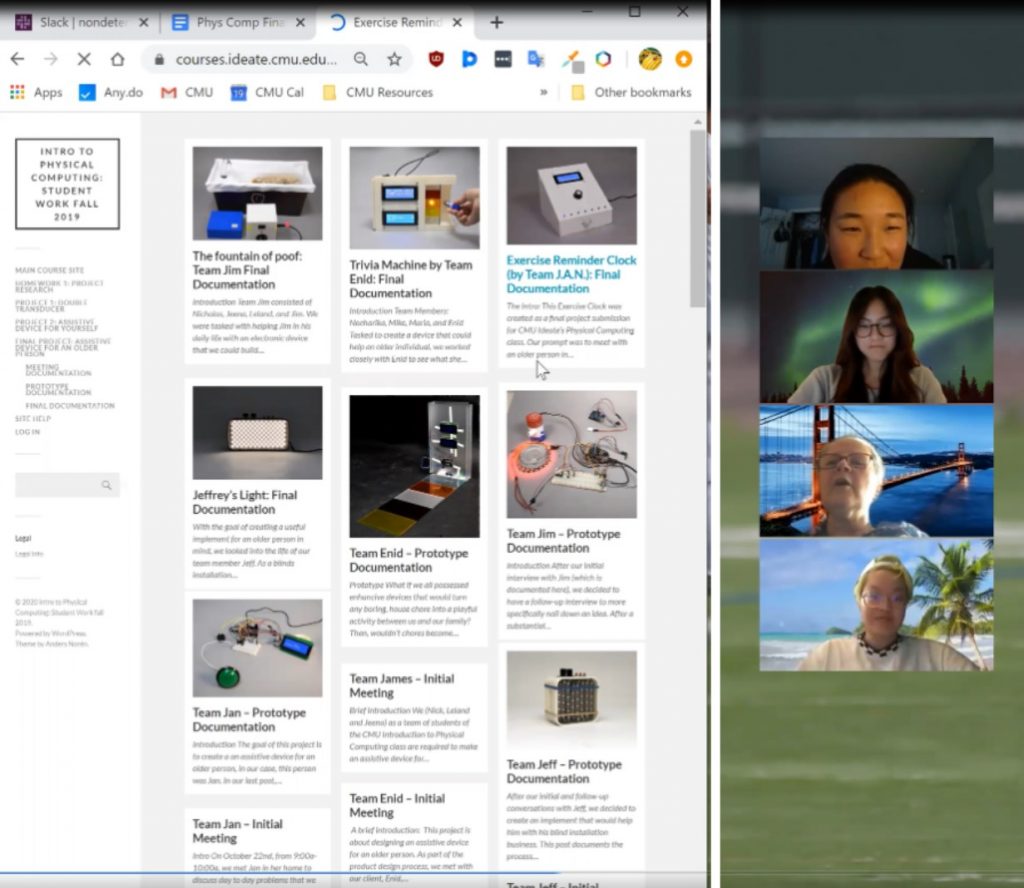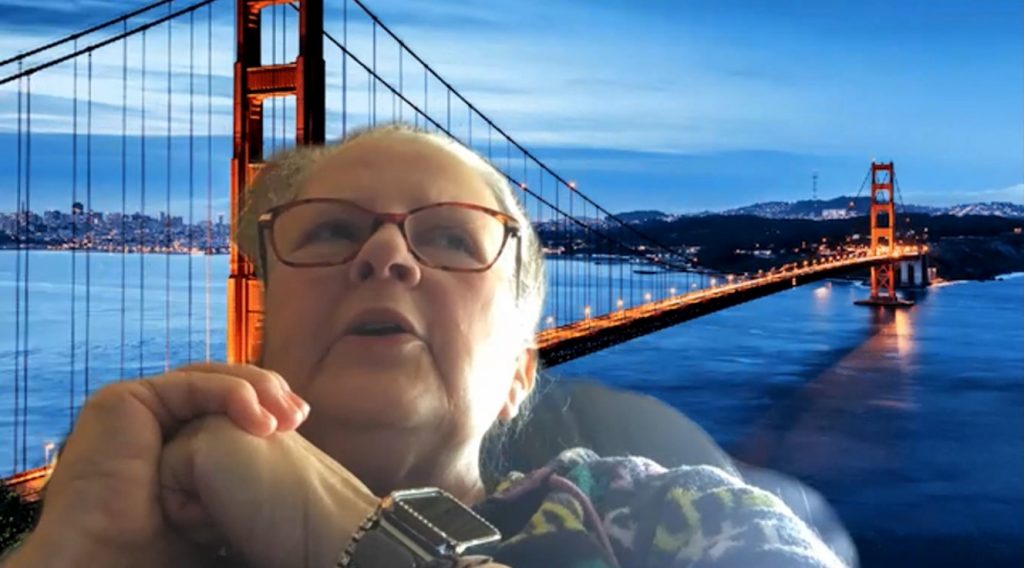On March 25th, 2020 at 11:00 am, Team Lynne, consisting of Sue, Hojung, and Achilles, interviewed an Osher student named Lynne, to kick-off our Physical Computing class’s five-week final project: to prototype an assistive device for an older person. The main purpose of the meeting was to introduce ourselves to Lynne and learn about the things she does in her average day that could possibly be improved by using a technological intervention.
Meeting Agenda:
A brief outline of our meeting was as follows:
- Introducing ourselves and letting Lynne introduce herself
- Explaining our project goals and what we are and are not doing
- Giving a timeline of our project, when and what to expect
- Giving her some ideas for certain times of the day which Lynne may have some problems to address
- Allowing Lynne to walk through her day with us
- Q&A about some of the things Lynne addressed in her daily activities
- Concluding the interview and reiterating the timeline of our project
Full timeline of the discussion is as follows:
Icebreaker/ Instructions:
Acknowledge the atypical circumstance of conducting this meeting remotely.
Introduce our names and something that reflects our interest, or other bits of relevant data about our life.
For Lynne:
- Could you also introduce yourself and maybe how long you’ve been living in Pittsburgh or what you like about it?
- Why did you decide to participate in this group activity?
- Could you share something that reflects a personal value or interest?
Explanation and clarification about project goals
- We are:
- Trying to build prototype useful devices (“a convenience machine/gadget”)
- Engaging in an iterative design process that includes gathering feedback midway through the process
- Documenting our process
- Capable of simulating somewhat complex electronics via Tinkercad, and more complex physical objects/devices via CAD software
- Examples of previous projects: light that could simulate different types of natural lighting for someone who worked installing window blinds; trivia machine to answer trivia questions while washing dishes for someone who disliked dish washing but loved trivia
- We are not:
- Professional technologists who are experienced in making polished products
- Planning to build something that will be sold commercially
- Constrained by any practicality outside of usefulness to you
- Likely to invent a totally novel piece of electronics (we will combine existing available components in new ways, but will not make components)
- A quick timeline overview of the process:
- Today: Interview to get an idea of what to make
- Week 1: Coming up with a device that would help you with something in your daily life; should have three ideas we could discuss
- Week 2: Develop a prototype that we will be presenting to you + class
- Working on the final product [deliverable]
- Week 5: Final critique from you & other’s
Interview Questions:
- Our big picture question: “Do you have any difficult or frustrating daily life activities that could use an intervention?”
- Just to get some ideas rolling, an average day can probably be broken up into the following sections:
- Waking up/Preparing for bed
- Breakfast/Lunch/Dinner
- Work/Travel/Post-work
- Could you walk us through your day and highlight the inconveniences that you encounter throughout?
- Is there a repetitive task you wish could be automated by a device?
- Is there a daily/weekly task you do that could use a more effective reminder?
- Is there an activity you do with friends or colleagues which could be improved by a device?
- Can you think of anything which has become harder with age?
- Perhaps of a hobby, you picked up or have been doing?
- Is there a hobby or goal you wish to accomplish but have trouble with?
Conclusion:
- Thank you for your time!
- Reiterate overall project schedule:
- 1 week later: 3 idea sketches
- 2 weeks later: initial prototype
- 5 weeks later: final critique
- Any final thoughts or questions?
- Feel free to email us if you have any questions or any new ideas!
- We will get back to you on Monday with the three ideas we generated just to keep you updated.

Screen sharing to show Lynne examples of past projects
Meeting Summary and Discussion:
Over the course of the meeting, we learned that her continued problem has been her joints in the hands due to arthritis and ways to ease the pain from it. She has been working full time in Property Management for commercial real estate which requires her to type often, which became the biggest factor for her arthritis pain in the hands. In addition, during her free time, she often occupies herself on her iPad, typing letters, which requires her to excessively use her hands as well. Her underlying problems also have factored in with her calcium deposits on her fingers, her osteoporosis, and her degenerative disease. While she had such problems, it was very clear that she is very positive and kept herself happy with her dog, Mendy, her two cats, and her friends she calls and hangs out with often.

Lynne showing us her calcium deposits

Lynne showing us her pet dog, “Mendy”
In our interview, we discussed briefly about her daily tasks every morning during weekdays, which consisted of trying to keep Mendy occupied while she was in the shower or working on her job. This led her to see another potential problem we could solve: how do we keep Mendy occupied while Lynne is busy. Throughout the interview, she mentioned how some tasks created problems for her pains and how she sometimes dealt with them. We focused on her arthritis for most of the interview. She mentioned that her pain gets worse when she constantly uses her hands, mostly for typing, and she often feels that the best way to ease the pain is to use heat, massage, or rest her hands entirely. Her calcium deposits also came into play during the time she was at the peak of her pain. She gave us insight into her process, as quoted:
“I have arthritis, big time arthritis. And my hands, I spent a lot of time on the computer, and my hands tend to bother me…and they hurt.”
“Having not been on the computers 8 hours a day sometimes, they are a little better right now than they tend to be and winter’s a bad time.”
“My toughest part of the day is just doing certain things with the hands when they hurt. Sometimes heat will help and sometimes massage.”
“When I’m doing all the typing and using the keyboard, that’s when the problems pursue.”
“Best thing for me to do is rest my hands and not use them so much.”

We noticed that while recounting her day, Lynne repeatedly massaged her joints.
During the interview, she also mentioned her osteoporosis, which limited her activity and its intensity. Lynne often likes to go on walks with Mendy and her friends, but she said there have been times she cannot due to problems with the weather. This led up to the question of what she does in her free time, as quoted:
“My interest, let’s see, I spent a lot of time on the computer too. I am into iPads. I am on here a lot. And I love to walk. Mendy and I walk a lot.”
She mentioned that she loves using her iPad. While she sometimes reads books, goes on walks, and watches TV. she said recently gotten into using her iPad. On her iPad she mentioned that she uses it for writing letters, playing games, browsing the internet, and online shopping. She also mentioned that the iPad’s diction feature creates more work for her because she has to go back in and fix up the autocorrect, which strains her hands as well. This led us to notice that even during her free time, she often uses her hands for most of these tasks. Noticing the problem, we threw in the idea about perhaps making a device that keeps her occupied while not using her hands, besides television, and she seemed to be very interested in the possible idea.
Afterthoughts and Discussion:
Overall, we were able to follow the meeting agenda fairly well. Lynne was very cooperative and did her best to answer each question we presented her with, while also going on appropriate tangents when helpful. After we had exhausted each question, we moved onto the next and continued to gain new, meaningful information. Although some questions led Lynne to repeat herself, Lynne consistently was able to provide us with new information the second time around. For example, “Could you walk us through your day?” made Lynne revisit the topic of her arthritis, which she mentioned in her answer to “Why did you join this project?.” However, the second time around, Lynne provided us with new insight into the remedies of heat and massage that she has tried.
Sue tried to open up the meeting by asking Lynne how she was doing, given the unprecedented circumstances (put in place by COVID-19), but Lynne stepped in and asked if we could first introduce ourselves to each other. Next time, we will probably follow Lynne’s example and begin our interview with introductions. Making sure our interviewee is doing okay with adjusting to the circumstances can be naturally weaved into our introductions.
A couple of days after our interview, we had quite a few follow-up questions pop-up amongst our team that we wished to have asked Lynne. These included:
- How do you play with Mendy?
- Does Mendy like wearing clothes?
- Does petting Mendy hurt your hands?
- Any video/computer games you like to play?
- Do you have a lot of floor space inside your house (for games of chase or fetch)?
- Do you use your computer or iPad at a desk? On your couch?
Based on the idea that we ended up choosing, we narrowed down our list of follow-up questions and reconnected with Lynne to gain some more insight on developing our prototype.
Overall, we think the interview went pretty well! Lynne is an incredibly lovely and friendly woman and she was extremely cooperative throughout the entire call. We could tell she was trying her best to provide her with useful information so we would be able to come up with a meaningful project idea. She made us feel very comfortable and the cuteness of her dog, Mendy, was an added bonus.

Comments are closed.